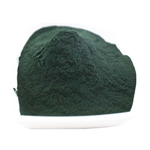- Hemin
-

- $10.00 / 1KG
-
2025-04-16
- CAS:16009-13-5
- Min. Order: 100KG
- Purity: 99%
- Supply Ability: 100 mt
- Hemin
-

- $70.00 / 1KG
-
2025-04-16
- CAS:16009-13-5
- Min. Order: 1KG
- Purity: 2%-8% HPLC,USP Standard
- Supply Ability: 1000KGs
- Hemin
-

- $990.00 / 1g
-
2025-04-16
- CAS:16009-13-5
- Min. Order: 1g
- Purity: 99%
- Supply Ability: 5000
|
| | Hemin Chemical Properties |
| Melting point | 300 °C | | storage temp. | 2-8°C | | solubility | 1.4 M NaOH: soluble25mg/mL | | form | crystal | | color | black | | biological source | Porcine | | Water Solubility | practically insoluble | | Merck | 14,4644 | | BRN | 5229914 | | Exposure limits | ACGIH: TWA 1 mg/m3
NIOSH: TWA 1 mg/m3 | | Stability: | Stable. Incompatible with strong oxidizing agents. Combustible. | | InChIKey | BTIJJDXEELBZFS-HXFTUNQESA-K | | SMILES | [Cl-][Fe+3]123[N-]4C5C(C)=C(C=C)C4=CC4C(C)=C(C=C)C(=CC6=C(C)C(CCC(=O)[O-])=C(C=C7C(CCC(=O)[O-])=C(C)C(C=5)=N17)[N-]26)N3=4.[H+] | | EPA Substance Registry System | Ferrate(2-), chloro[7,12-diethenyl-3,8,13,17-tetramethyl-21H,23H-porphine-2,18-dipropanoato(4-)-.kappa.N21,.kappa.N22,.kappa.N23,.kappa.N24]-, dihydrogen, (SP-5-13)- (16009-13-5) |
| Hazard Codes | Xi | | Risk Statements | 36/37/38 | | Safety Statements | 24/25-22-36-26 | | WGK Germany | 3 | | RTECS | LJ8080000 | | F | 8 | | TSCA | Yes | | HS Code | 29349990 |
| | Hemin Usage And Synthesis |
| Description | Hemin is a metalloporphyrin compound with a relatively simple structure. It is formed by the complexation of a molecule of ferrous iron and protoporphyrin. It is an in vitro group substitute of natural heme and its chemical properties are similar to that of heme. Heme, an essential small molecule in living organisms, can be found abundantly in various organisms including animals, plants, microorganisms, and algae. | | Chemical Properties | Hemin is a Dark purple crystalline powder or elongated needle-shaped crystal. It does not dissolve in water, but it can dissolve in acidic acetone and alkaline water. The molecular formula is C34H32ClFe(III)N4O4, and the molecular weight is 651.96. Hemin is mainly used as raw material for anti-anemia and anti-cancer drugs. | | Application | Hemin is used for the following applications:
To study bacterial strains and growth conditions
Used in short-term colony assays (the culture medium consists of hemin along with other components)
Cell transfections
It may be used in β-hematin formation assay for analyzing the inhibitory activity of MMV (Medicines for Malaria Venture) Malaria Box compounds against the formation of β-hematin. | | Uses | Hemin is used in cellular protection and control mechanism. It stimulates the synthesis of globulin. It is also used to study the bacterial strains and growth conditions, in the short-term colony assays and cell transfections. Further, it is used to treat the symptoms of various porphyrias. In addition, it is used in the preparation of agar medium for the bacteria culture. | | General Description | Heme is a small molecule present either free or bound to hemoglobin in the bloodstream of mammals. This is an alternative source of iron within the host that contains a porphyrin ring containing a Fe2+ ion called hemin. | | Biochem/physiol Actions | Hemin, the oxidized version of heme, is an iron-containing prosthetic group for a diverse group of proteins. Free heme, which can be released from hemoglobin following hemolysis, is pro-inflammatory and contributes to iron-derived reactive oxygen species. Free hemin levels may be upregulated in various pathological conditions and can contribute to various inflammatory conditions including vascular disorders, renal failure, and immune-mediated disorders.Hemin may be used to study the expression and represson of heme oxygenase 1 (HO-1) as well as the activity of HO-1. Hematin is the "X factor" required to grown Haemophilus influenzae. | | Purification Methods | Hemin is purified by recrystallisation from AcOH. Also, hemin (5g) is shaken in pyridine (25mL) till it dissolves, then CHCl3 (40mL) is added, the container is stoppered and shaken for 5minutes (releasing the stopper occasionally). The solution is filtered under slight suction, and the flask and filter are washed with a little CHCl3 (15mL). During this period, AcOH (300mL) is heated to boiling, and saturated aqueous NaCl (5mL) and conc HCl (4mL) are added. The CHCl3 filtrate is poured in a steady stream, with stirring, into the hot AcOH mixture and set aside for 12hours. The crystals are filtered off, washed with 50% aqueous AcOH (50mL), H2O (100mL), EtOH (25mL), Et2O and dried in air. [Fischer Org Synth Coll Vol III 442 1955, Beilstein 26 III/IV 3048.] |
| | Hemin Preparation Products And Raw materials |
|